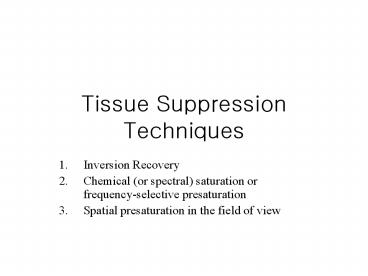Tissue Suppression Techniques - PowerPoint PPT Presentation
1 / 14
Title:
Tissue Suppression Techniques
Description:
If TI=(ln 2) T1(tissue x)=0.693 T1 (tissue x) then tissue x is nulled ... suppress either venous flow (for arteriography) or arterial flow (for venography) ... – PowerPoint PPT presentation
Number of Views:53
Avg rating:3.0/5.0
Title: Tissue Suppression Techniques
1
Tissue Suppression Techniques
- Inversion Recovery
- Chemical (or spectral) saturation or
frequency-selective presaturation - Spatial presaturation in the field of view
2
Inversion Recovery (IR) Techniques
- If TI(ln 2) T1(tissue x)0.693 T1 (tissue x)
then tissue x is nulled - STIR (Short TI Inversion Recovery)
- At 1.5T, T1 of fat is approximately 200ms. Then
TI0.693 x 200 ms140 ms - FLAIR (Fluid Attenuated Inversion Recovery)
- At 1.5T T1 of CSF is approximately 3600ms. Then
TI0.693 x 3600 ms2500 ms - Fast FLAIR
- TR/TI/TEeff10000/2500/112ms, ETL8
3
MR tissue properties
4
Fat Suppression STIRShort Ti IR
Mz
100
MAGNETISATION along Z -AXIS
0
time/ms
-100
100
200
300
400
-Mz
5
Fluid Attenuated IR (FLAIR)
Mz
100
0
MAGNETISATION along Z -AXIS
time/ms
-100
-Mz
2000
6
GRASE vs. Fluid Attenuated IR (FLAIR)
T2 GRASE
Flair
TR 4500 / TF 8 / EF 3 / TE 100
TR 7000 / Ti 2100 / TE 150
7
Advantages and Disadvantages
- Advantages
- No extra RF heating
- No variability caused by magnetic field
inhomogeneities - Disadvantages
- Tissues with similar T1 values are all suppressed
and thus cannot be differentiated - Long acquisition times caused by long TR
- Low SNR
8
Chemical (spectral) presaturation
- At 1.5T water protons precess 220Hz faster than
fat protons - Presaturation pulse with resonance frequency of
water protons(or fat protons) is applied
immediately before the 90o pulse of the SE
9
- Advantages
- Resolves tissues with similar T1 values (fat and
gadolinium-enhanced tumors, or fat and blood
products) - No influence on the signal from tissues other
than the on being suppressed - Disadvantages
- Suffers from sensitivity to magnetic field
inhomogeneities - Requires extra time
10
Spatial Presaturation
- Reduce motion and flow-related artifacts fo
structures adjacent to-or actually within the FOV
nest to-the region of interest. - Spatial presaturation is accomplished by applying
an extra 90o pulse before the 90o pulse of the
SE. - Imaging of the spine a saturation band is placed
within the FOV anterior to the vertebral bodies
to suppress artifacts arising from the heart and
great vessels - MRA Saturation pulses are placed outside the FOV
at one end of a vessel to suppress either venous
flow (for arteriography) or arterial flow (for
venography)
11
Spatial Presaturation
12
Magnetization Transfer (MT)
- Suppress protein-bound water protons whose
resonance frequency is approximately 500 to 2500
Hz away from that of bulk water protons. - MT saturation pulses are simply off-resonant
pulses with their center frequency 1000 to 2000
Hz removed from the Larmor frequency of protons
and a BW of several hundred to several thousand Hz
13
(No Transcript)
14
- Application
- Time of Flight (TOF) MRA
- To suppress the background brain tissue to
enhance the visualization of smaller, more
peripheral vessels - MT effect in FSE
- In FSE the rapid 180o pulse have a broad BW that
contains frequencies off the bulk water resonance
frequency.































